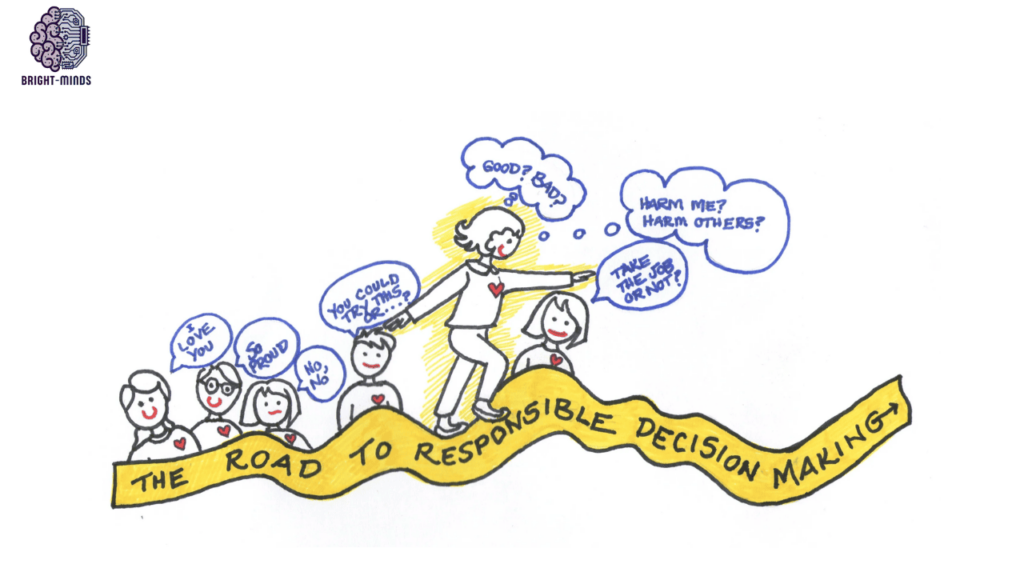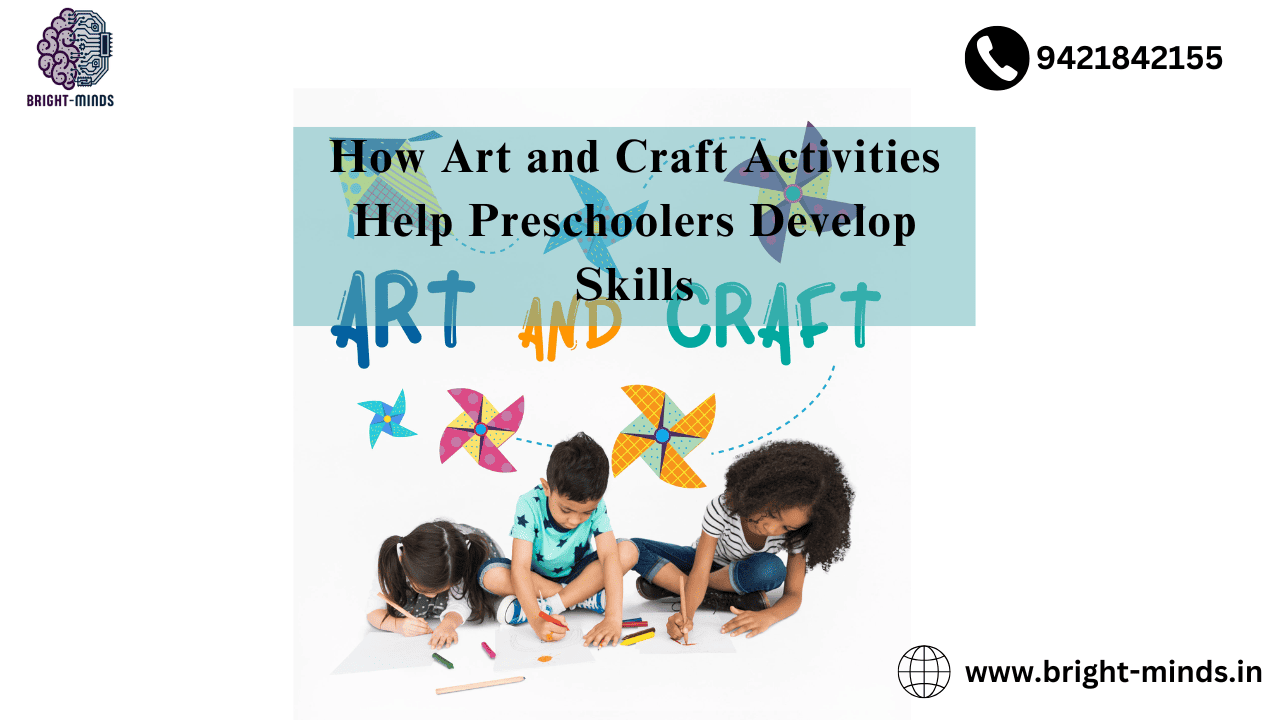Introduction
One of the best methods to support preschoolers’ development as they start their educational journey is through creative activities, especially art and crafts. A child’s physical, cognitive, social, and emotional development greatly benefits from these activities, which are frequently viewed as enjoyable and leisurely. This blog will examine the ways in which art and craft projects aid in preschoolers’ general growth and help them acquire lifelong skills.
1. Enhancing Fine Motor Skills
- The improvement of fine motor skills is among the most obvious advantages of involving preschoolers in art and craft projects. The tiny actions that require the use of tiny hand and finger muscles are known as fine motor abilities. For daily activities like writing, buttoning shirts, tying shoelaces, and gripping utensils, these abilities are essential.
- These muscles are strengthened by art-related activities like coloring, drawing, cutting with scissors, and gluing. Holding a crayon or paintbrush, cutting paper with scissors, and adhering items with glue all need for perfect hand-eye coordination. As kids get older, these repetitive actions help them develop the dexterity needed for other crucial tasks.
2. Boosting Cognitive Development
- Activities involving art and craft promote cognitive development in a number of ways. Children use their minds to solve problems, plan, and make decisions when they make art. For example, a youngster must consider the materials, colors, and shapes they will use when asked to draw a picture or put together a craft. They must also arrange their ideas and consider the procedures necessary to finish the assignment.
- Preschoolers can also learn and explore fundamental ideas like sizes, shapes, colors, patterns, and symmetry with the aid of these activities. For instance, coloring in a coloring book teaches children to identify and distinguish colors, and creating their artwork teaches them about balance and spatial awareness.
3. Improving Language and Communication Skills

- Preschoolers’ language and communication skills can be greatly enhanced by art and craft projects. Children frequently describe what they are doing while participating in these activities, which motivates them to improve sentence construction and utilize new language. Asking kids questions like “What colors are you using?” or “What does this shape look like?” might help teachers or other caregivers guide them. Children can express their ideas and increase their vocabulary with the aid of these prompts.
- Additionally, group art projects provide kids the chance to collaborate, exchange ideas, and share their experiences. This improves their listening and comprehension abilities in addition to their capacity for self-expression. Children practice social communication skills, which are essential for fostering relationships, as they learn to express their artistic preferences.
4. Fostering Emotional Development and Self-Expression
- An essential medium for expressing emotions is art. Preschoolers can communicate themselves nonverbally through art, even if they may not yet have the words or emotional maturity to do so. Children can express their feelings, experiences, and fantasies via art such as painting, crafts, or drawing.
- Children who participate in artistic activities also gain patience and learn coping mechanisms. Persistence is typically necessary to finish an art piece, particularly when things don’t go as planned. By practicing these abilities, preschoolers can become more adept at controlling their emotions and dealing with failures in a positive way. Additionally, the sense of achievement they get from finishing a piece of art can increase their self-esteem and confidence.
5. Encouraging Creativity and Problem-Solving
- Creativity is a cornerstone of childhood development, and art and craft activities encourage creative thinking. When preschoolers are given materials such as clay, paints, or fabric scraps, they are free to explore their ideas and create something unique. This freedom to experiment fosters their imagination and allows them to think outside the box.
- Art activities also teach problem-solving. Children might encounter challenges when their project doesn’t turn out the way they envisioned, such as when a drawing needs an adjustment or a sculpture collapses. These challenges encourage preschoolers to think critically, make adjustments, and find solutions. Such experiences lay the foundation for future problem-solving skills in more complex tasks later in life.
6. Social Skills and Collaboration
- Whether in the classroom or at home with friends or siblings, art and craft projects are frequently completed in groups. Preschoolers learn the importance of cooperation, sharing, and teamwork from this partnership. They learn to respect one another’s opinions, cooperate, and share resources. Children may need to coordinate when creating a group mural, for instance, in order to choose which colors to use, who will paint certain areas, or how to combine their ideas into a single, coherent piece.
- Additionally, children are encouraged to watch and learn from their peers through group art activities. By observing the creative decisions made by others, they can acquire fresh ideas and inspiration, which deepens their understanding of various viewpoints and methods. These social exchanges are a crucial component of social and emotional
7. Building Focus and Attention Span
- One of the main advantages of painting and craft activities is that they can help kids become more focused and have longer attention spans in a world full of distractions. Whether they are painting, drawing, or putting together a craft, children must focus on the work at hand when creating art. They get the ability to focus on a task for a long time through this practice, which is crucial for success in both their personal and academic lives.
- Children develop patience and tenacity as they learn to concentrate on the details of their artwork. These activities help kids improve their capacity to focus and finish tasks, whether they are meticulously coloring between the lines or following detailed directions for a craft.
8. Encouraging Independence and Decision Making

- Preschoolers are given the chance to make decisions through art and craft projects, which helps them develop a sense of independence. Children discover that their choices affect the outcome, whether they are selecting colors for a drawing or arranging forms in a collage. They get more self-assurance and learn to accept responsibility for their work as a result of this process.
- Additionally, youngsters learn initiative through hands-on creative activities. Giving them the means to create gives them the confidence to experiment with their concepts and realize their vision, which enhances their sense of independence and personal development.
9. Creating a Sense of Accomplishment and Pride
- When preschoolers complete an art project, they experience a sense of accomplishment and pride in their work. This is especially true when they have been given the freedom to create something of their own design. The act of making something with their hands, and then sharing it with others, boosts their self-esteem and encourages them to continue expressing themselves creatively.
- Teachers and parents can reinforce this feeling by praising the effort, process, and creativity involved in the project, rather than just focusing on the end result. This positive reinforcement motivates preschoolers to continue exploring their artistic abilities and builds a sense of pride in their work.
Conclusion
- For preschoolers, art and craft projects are much more than just entertaining hobbies. They offer a special and effective means of encouraging the growth of many different abilities, including fine motor, cognitive, linguistic, emotional, social, and creative. We assist children in acquiring critical life skills that will benefit them as they mature and learn by involving them in practical, imaginative activities. Painting, drawing, sculpting, and making are all excellent ways for preschoolers to express themselves, learn about the world, and develop into well-rounded, self-assured adults.
- Promoting art and craft activities in early childhood education is about more than simply creating beautiful images; it’s about giving kids the skills they need to thrive in all facets of life.
Also Read:
https://bright-minds.in/unlocking-word-meaning-for-class-ukg-english-to-hindi/

